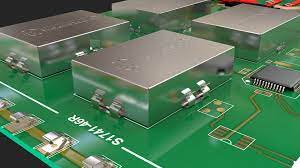The role of EMI gaskets in electronic devices and how to choose the right one for your application.
EMI (Electromagnetic Interference) is a phenomenon that can negatively affect electronic devices and their performance. EMI can come from a variety of sources, including power lines, radio waves, and electronic devices themselves. To prevent EMI from interfering with the functioning of electronic devices, EMI gaskets are used to provide a barrier between the electronic device and the outside world.
EMI gaskets are essentially seals that are designed to block electromagnetic radiation from entering or leaving the electronic device. They are typically made from conductive materials, such as metals or conductive elastomers, and are installed in the gaps between different parts of the electronic device or between the device and its enclosure. The EMI gasket provides a conductive path that allows the electromagnetic waves to be absorbed or reflected, preventing them from entering or leaving the device.
Choosing the right EMI gasket for your electronic device can be a challenging task. There are many different factors that need to be considered, including the frequency of the EMI, the size and shape of the enclosure, and the desired level of shielding effectiveness. Here are some important considerations to keep in mind when choosing an EMI gasket for your application:
Frequency Range
The frequency range of the EMI is an important factor to consider when choosing an EMI gasket. Different materials and designs of EMI gaskets have varying levels of effectiveness at different frequencies. For example, a conductive elastomer gasket may be effective at lower frequencies, while a metal mesh gasket may be more effective at higher frequencies. It is important to choose an EMI gasket that is specifically designed to shield against the frequency range of the EMI that is affecting your device.
Enclosure Size and Shape
The size and shape of the enclosure are important considerations when choosing an EMI gasket. The EMI gasket must be able to fit into the gaps between different parts of the enclosure or between the enclosure and the device. The EMI gasket must also be able to conform to the shape of the enclosure and be compressed to provide an effective seal. It is important to choose an EMI gasket that is designed to fit your specific enclosure and device.
Shielding Effectiveness
The level of shielding effectiveness required for your application is an important consideration when choosing an EMI gasket. The shielding effectiveness is the amount of electromagnetic radiation that is blocked by the EMI gasket. The level of shielding effectiveness required will depend on the sensitivity of the electronic device and the level of electromagnetic radiation in the environment. It is important to choose an EMI gasket that has a shielding effectiveness that meets the requirements of your application.
Material and Design
The material and design of the EMI gasket are important factors to consider when choosing an EMI gasket. Different materials, such as conductive elastomers, metal mesh, or conductive foams, have different levels of conductivity and effectiveness at different frequencies. The design of the EMI gasket can also affect its effectiveness. For example, a fingerstock gasket may be more effective at blocking EMI in a gap with irregular shape, while a conductive foam gasket may be more effective in a gap with a consistent shape. It is important to choose an EMI gasket that is designed with the appropriate material and design to meet the requirements of your application.
In conclusion, EMI gaskets play a critical role in preventing EMI from interfering with the functioning of electronic devices. Choosing the right EMI gasket for your application can be challenging, but by considering factors such as the frequency range of the EMI, the size and shape of the enclosure, the desired level of shielding effectiveness, and the material and design of the EMI gasket, you can make an informed decision




